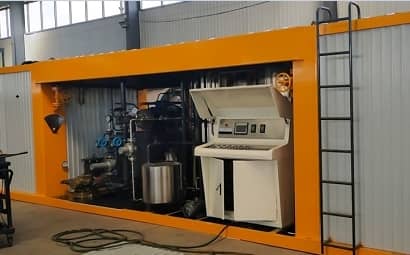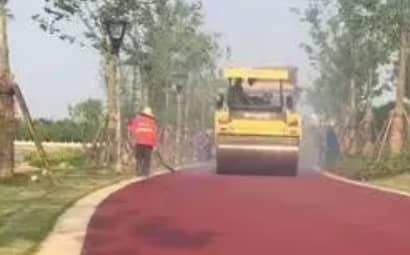The base layer of asphalt pavement is divided into semi-rigid and rigid. Since the base layer and the surface layer are materials of different properties, good bonding and continuity between the two are the key requirements for this type of pavement. In addition, when the asphalt surface layer seeps water, most of the water will be concentrated at the joint between the surface layer and the base layer, causing damage to the asphalt pavement such as slurry, looseness, and potholes. Therefore, adding a lower seal layer on top of a semi-rigid or rigid base layer will play a vital role in enhancing the strength, stability and waterproofing capabilities of the pavement structural layer. The more commonly used one is to use asphalt gravel synchronous sealing technology.


So let’s take a look at how the construction of the asphalt gravel synchronous seal truck is carried out:
(1) Crushing. The waterproof layer that has just been sprinkled (sprinkled) cannot be rolled immediately, otherwise the high-temperature modified asphalt will adhere to the tires of the rubber tire roller and remove the gravel. When the temperature of the SBS modified asphalt drops to about 100°C, use a rubber-tired road roller to stabilize the pressure for one round trip and control the driving speed at 5~8km·h-1, so that the gravel is pressed into the modified asphalt and bonded firmly.
(2) Maintenance. After the sealing layer is laid, it is strictly forbidden for construction vehicles to brake suddenly and make a U-turn. Traffic should be closed until the construction of the SBS modified asphalt seal layer is closely connected with the construction of the lower layer, then the lower asphalt layer will be constructed, and the lower layer can be opened to traffic only after the lower layer is paved. On the surface of the waterproof layer formed by the rubber tire roller, the bond between gravel and asphalt is very strong. The modified asphalt has great ductility (elastic recovery) and plays the role of a stress absorption layer, which can effectively delay and reduce the cracks in the base layer on the surface layer. reflective cracks.
(3) On-site quality inspection. Appearance inspection shows that the asphalt spreading in the asphalt seal layer should be evenly spread without leakage or excessive oil layer; the single-grained gravel in the asphalt layer and aggregate layer should be evenly spread without being heavy or leaking. Spreading amount detection is divided into total amount detection and single point detection; the former controls the overall spreading amount of the construction section, weighs the gravel and asphalt, calculates the spreading area according to the length and width of the spreading section, and then calculates the construction section Overall spread; the latter controls the amount and uniformity of spread at individual points.
 Albanian
Albanian  Russian
Russian  Arabic
Arabic  Amharic
Amharic  Azerbaijani
Azerbaijani  Irish
Irish  Estonian
Estonian  Odia (Oriya)
Odia (Oriya)  Basque
Basque  Belarusian
Belarusian  Bulgarian
Bulgarian  Icelandic
Icelandic  Polish
Polish  Bosnian
Bosnian  Persian
Persian  Afrikaans
Afrikaans  Tatar
Tatar  Danish
Danish  German
German  French
French  Filipino
Filipino  Finnish
Finnish  Frisian
Frisian  Khmer
Khmer  Georgian
Georgian  Gujarati
Gujarati  Kazakh
Kazakh  Haitian Creole
Haitian Creole  Korean
Korean  Hausa
Hausa  Dutch
Dutch  Kyrgyz
Kyrgyz  Galician
Galician  Catalan
Catalan  Czech
Czech  Kannada
Kannada  Corsican
Corsican  Croatian
Croatian  Kurdish (Kurmanji)
Kurdish (Kurmanji)  Latin
Latin  Latvian
Latvian  Lao
Lao  Lithuanian
Lithuanian  Luxembourgish
Luxembourgish  Kinyarwanda
Kinyarwanda  Romanian
Romanian  Malagasy
Malagasy  Maltese
Maltese  Marathi
Marathi  Malayalam
Malayalam  Malay
Malay  Macedonian
Macedonian  Maori
Maori  Mongolian
Mongolian  Bengali
Bengali  Myanmar (Burmese)
Myanmar (Burmese)  Hmong
Hmong  Xhosa
Xhosa  Zulu
Zulu  Nepali
Nepali  Norwegian
Norwegian  Punjabi
Punjabi  Portuguese
Portuguese  Pashto
Pashto  Chichewa
Chichewa  Japanese
Japanese  Swedish
Swedish  Samoan
Samoan  Serbian
Serbian  Sesotho
Sesotho  Sinhala
Sinhala  Esperanto
Esperanto  Slovak
Slovak  Slovenian
Slovenian  Swahili
Swahili  Scots Gaelic
Scots Gaelic  Cebuano
Cebuano  Somali
Somali  Tajik
Tajik  Telugu
Telugu  Tamil
Tamil  Thai
Thai  Turkish
Turkish  Turkmen
Turkmen  Welsh
Welsh  Uyghur
Uyghur  Urdu
Urdu  Ukrainian
Ukrainian  Uzbek
Uzbek  Spanish
Spanish  Hebrew
Hebrew  Greek
Greek  Hawaiian
Hawaiian  Sindhi
Sindhi  Hungarian
Hungarian  Shona
Shona  Armenian
Armenian  Igbo
Igbo  Italian
Italian  Yiddish
Yiddish  Hindi
Hindi  Sundanese
Sundanese  Indonesian
Indonesian  Javanese
Javanese  Yoruba
Yoruba  Vietnamese
Vietnamese  Hebrew
Hebrew  Chinese (Simplified)
Chinese (Simplified)







